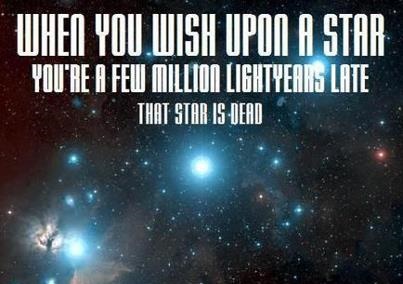It looks like you're using an Ad Blocker.
Please white-list or disable AboveTopSecret.com in your ad-blocking tool.
Thank you.
Some features of ATS will be disabled while you continue to use an ad-blocker.
share:
You really don't seem to understand exposure. First, ISO 400 is not considered high. You really don't start getting into high ISO until 1600.
Second, ISO alone tells you nothing about the level of light captured. Exposure is a combination of time, aperture, and ISO. Shooting at f/8, 1/250 sec, ISO 100 produces the exact same exposure as shooting at f/8, 1/1000 sec, ISO 400, or f/5.6, 1/250 sec, ISO 200.
Second, ISO alone tells you nothing about the level of light captured. Exposure is a combination of time, aperture, and ISO. Shooting at f/8, 1/250 sec, ISO 100 produces the exact same exposure as shooting at f/8, 1/1000 sec, ISO 400, or f/5.6, 1/250 sec, ISO 200.
a reply to: nataylor
Other experts tell me it's not that simple. Going by the results of online programs that let you punch in some numbers and give back recommendations, using the exposure setting used for the NASA shots, overexposure is the result of even an ISO 200 setting. I realise some of the Nikons were modified, mainly to increase IR sensitivity I think, so the online calculators can not be fully relied on, but this is where more experiments are needed. Lets use the same camera set for ISO 100 and look at the results, including the bracketed shots. Lets try an unmodified camera to eliminate the chance we are seeing near IR too. The impressions of the EVA astronauts would be interesting, but they only ever show or talk about the moon when it is clear they are looking through Earths atmosphere, not outwards.
I'll set up my old Nikon some time and play around with some settings with Moon shots, experiments are still the best way I think.
Shooting at f/8, 1/250 sec, ISO 100 produces the exact same exposure as shooting at f/8, 1/1000 sec, ISO 400, or f/5.6, 1/250 sec, ISO 200.
Other experts tell me it's not that simple. Going by the results of online programs that let you punch in some numbers and give back recommendations, using the exposure setting used for the NASA shots, overexposure is the result of even an ISO 200 setting. I realise some of the Nikons were modified, mainly to increase IR sensitivity I think, so the online calculators can not be fully relied on, but this is where more experiments are needed. Lets use the same camera set for ISO 100 and look at the results, including the bracketed shots. Lets try an unmodified camera to eliminate the chance we are seeing near IR too. The impressions of the EVA astronauts would be interesting, but they only ever show or talk about the moon when it is clear they are looking through Earths atmosphere, not outwards.
I'll set up my old Nikon some time and play around with some settings with Moon shots, experiments are still the best way I think.
a reply to: GaryN
One could take a digital SLR (identical to the one used for those ISS photos, but that's not necessary), set it to the same settings, and take pictures of the Moon from the ground. Will they show a much brighter Moon? I doubt that. ISO 400 isn't that high, and with a short exposure time it can keep the Moon from being overexposed.
Here's a crop from an image I took on March 1st using Canon 600D, with ISO 400, f/5.6, 1/640 exposure time:
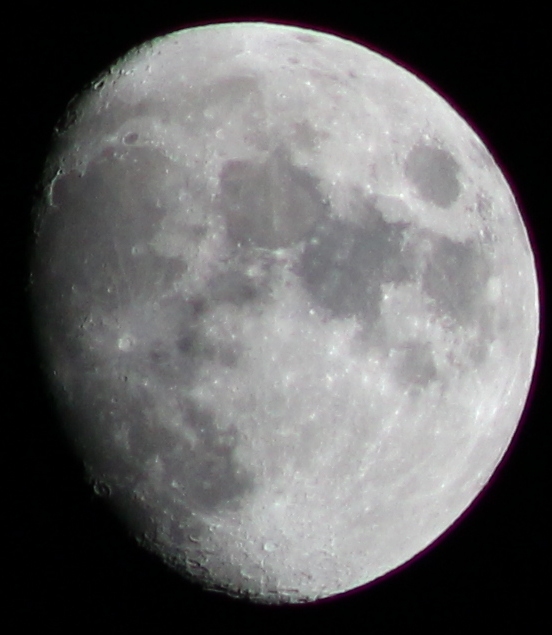
[Edit] ATS image servers seem to be offline, so here's a link to my photo: s22.postimg.org...
For the photo we've been discussing, the exposure time was 1/2000 which is a lot shorter! If the Moon, like you say, is very dim in space, it would have hardly been visible in the photo, if at all.
As for comparing images on the screen with what the human eyes see is a tricky business; the eyes have a bigger dynamic range than a camera, and can adapt to different lighting conditions.
One could take a digital SLR (identical to the one used for those ISS photos, but that's not necessary), set it to the same settings, and take pictures of the Moon from the ground. Will they show a much brighter Moon? I doubt that. ISO 400 isn't that high, and with a short exposure time it can keep the Moon from being overexposed.
Here's a crop from an image I took on March 1st using Canon 600D, with ISO 400, f/5.6, 1/640 exposure time:

[Edit] ATS image servers seem to be offline, so here's a link to my photo: s22.postimg.org...
For the photo we've been discussing, the exposure time was 1/2000 which is a lot shorter! If the Moon, like you say, is very dim in space, it would have hardly been visible in the photo, if at all.
As for comparing images on the screen with what the human eyes see is a tricky business; the eyes have a bigger dynamic range than a camera, and can adapt to different lighting conditions.
edit on 30-5-2015 by wildespace because: (no reason given)
edit on 30-5-2015 by
wildespace because: (no reason given)
oh so ALL space ward
points of light we've seen
in shuttle and space station
videos explained by NASA as stars
are UFO's after all.
I'll call the newspapers.
Both of them.
points of light we've seen
in shuttle and space station
videos explained by NASA as stars
are UFO's after all.
I'll call the newspapers.
Both of them.
a reply to: GaryN
What experts ?
Many on here are long time amateur photographers or even pro. I have been clicking the shutter button for 35 years + now first camera I got was a fully manual SLR now like most I went digital more than 10 years ago when 2mp was good!
There is a thing called the exposure triangle go look it up, that shows the relationship between iso, f numer & shutter speed.
Other things to consider if a picture is taken in raw format depending on sensor quality you can have a few stops under/over exposure a still produce a reasonable picture.
Plenty of astro images on here to look at taken by members .
What experts ?
Many on here are long time amateur photographers or even pro. I have been clicking the shutter button for 35 years + now first camera I got was a fully manual SLR now like most I went digital more than 10 years ago when 2mp was good!
There is a thing called the exposure triangle go look it up, that shows the relationship between iso, f numer & shutter speed.
Other things to consider if a picture is taken in raw format depending on sensor quality you can have a few stops under/over exposure a still produce a reasonable picture.
Plenty of astro images on here to look at taken by members .
Regarding the setting used for that ISS zenith moon shot (ISO 400, f/5.6, 1/2000), they seem to be the suggested settings for the full moon, as
photographed from Earth:
Link 1,
Link 2.
One could compare that series of ISS zenith moon shots to the numerous ISS moon shots where it's near the Earth's limb, and see if the Moon becomes any brighter (as it should according to GaryN's theory). From the shots that I've seen where the Moon is "setting" behind the Earth's atmosphere, it actually becomes dimmer (and redder) as some of its light gets blocked or scattered away by the atmosphere. astrobob.areavoices.com...
One could compare that series of ISS zenith moon shots to the numerous ISS moon shots where it's near the Earth's limb, and see if the Moon becomes any brighter (as it should according to GaryN's theory). From the shots that I've seen where the Moon is "setting" behind the Earth's atmosphere, it actually becomes dimmer (and redder) as some of its light gets blocked or scattered away by the atmosphere. astrobob.areavoices.com...
edit on 31-5-2015 by wildespace because: (no
reason given)
originally posted by: awareness10
Illusion..
Not necessarily, as all stars that are visible to the naked eye are fairly close - from a few light years to a few thousand light years away from us. Our whole galaxy is approximately 100,000 light years across.
Stars can live for billions of years (our Sun has been around for 5 billion years or so), and even the most massive stars that only live a short life still live for millions of years.
There's a few stars you can see that are close to the end of their life, so they might indeed not be there anymore, but generally speaking, the vast majority of the stars you see are still there.
cosmoquest.org...
a reply to: wildespace
Nice Moon image, but your Moon is a little larger than the Moon seen from the Zenith port. Why did they use the lens they did? At 2:30 in this Space Station live video, the experiment and it's purpose are described.
www.youtube.com...
With such a small Moon from the NASA shot, lots of black background, what will the camera do as compared to taking an image like yours which is mostly white?
@wildespace
I'll check those links out, thanks.
Nice Moon image, but your Moon is a little larger than the Moon seen from the Zenith port. Why did they use the lens they did? At 2:30 in this Space Station live video, the experiment and it's purpose are described.
www.youtube.com...
With such a small Moon from the NASA shot, lots of black background, what will the camera do as compared to taking an image like yours which is mostly white?
@wildespace
Regarding the setting used for that ISS zenith moon shot (ISO 400, f/5.6, 1/2000), they seem to be the suggested settings for the full moon, as photographed from Earth: Link 1, Link 2.
I'll check those links out, thanks.
originally posted by: GaryN
a reply to: wildespace
Nice Moon image, but your Moon is a little larger than the Moon seen from the Zenith port.
First of all, the image I posted is a 100%-scale crop of the original photo. Here's what the whole frame looks like:
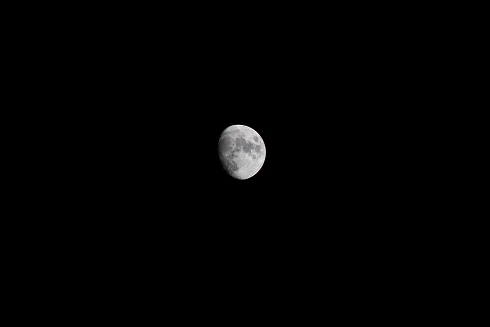
With such a small Moon from the NASA shot, lots of black background, what will the camera do as compared to taking an image like yours which is mostly white?
As I just explained, my shot is also mostly black with a fairly small Moon. It would take an enormous telephoto lens to make the Moon fill most of the view. Such as the 1200mm lens, which they do by the way have on the ISS.
In any case, both their and mine cameras were set to manual, so there's nothing the camera can "do" apart from obeying the manual settings and getting exactly as much light as was allowed to get to the sensor.
edit on 31-5-2015 by wildespace because: (no reason given)
originally posted by: GaryN
a reply to: wildespace
Nice Moon image, but your Moon is a little larger than the Moon seen from the Zenith port. Why did they use the lens they did? At 2:30 in this Space Station live video, the experiment and it's purpose are described.
www.youtube.com...
With such a small Moon from the NASA shot, lots of black background, what will the camera do as compared to taking an image like yours which is mostly white?
@wildespace
Regarding the setting used for that ISS zenith moon shot (ISO 400, f/5.6, 1/2000), they seem to be the suggested settings for the full moon, as photographed from Earth: Link 1, Link 2.
I'll check those links out, thanks.
The exif data says MANUAL EXPOSURE you do know what that means.
One of mine MANUAL EXPOSURE
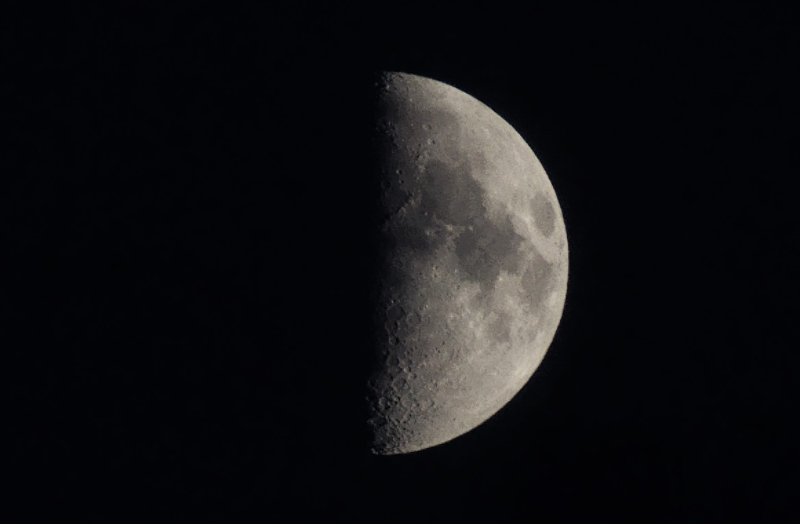
1/400th of a second f8 iso 400, Sony SLT A37 with a 300mm lens (heavy crop)
All we are now seeing is YOU back peddling YOU said months ago if you saw a picture of the Moon or Stars pointing away from the Earth then that would show YOU were wrong, now all YOU are doing is looking for excuses because YOU were wrong all along!!!
edit on 31-5-2015 by wmd_2008 because:
(no reason given)
a reply to: wildespace
The moons is pretty full tonight, so if it is clear out, I'll go out and play around, but I seem to remember that when I last imaged the moon, a few years ago now, on full auto the camera chose iso 100, f/8 and 1/30. Be a good test of if my memory is any good too!
With the explanation of the reason for the experiment, if they were on their way to Mars (which I don't think will happen in my life time), and assuming they have a porthole to look out of, then why couldn't they just use the old fashioned navigation method? The Sun and planets should all be easily identifiable, so someone trained in the art shouldn't have any problem. Magnification of a starscope or sunscope should be plenty. They'd be taking a decent pair of binoculars or a telescope too I imagine, heck, you can see galaxies and even double stars through my bins, why do they need anything more complicated?
@wmd_2008
The Moon would seem to be visible, yes, they didn't show the stars, and never have through that porthole, AFAIK. Of course they aren't on the ISS to do astronomy or astrophotography. Otherwise, there is still something fishy around this experiment, and I still don't trust NASA one iota. I'm trying to figure out the Moons elevation a little more accurately at the time the Zenith port images were taken, like to be able to do it myself, but may have to ask for help. And still looking at more images from the eol.jsc.nasa.gov site, there are other sets previous to those we have looked at, maybe more later? I've tried numerous search terms and don't see any media releases about the experiment at all, or any NASA reports on the results. Don't count your chickens yet I'd say.
The moons is pretty full tonight, so if it is clear out, I'll go out and play around, but I seem to remember that when I last imaged the moon, a few years ago now, on full auto the camera chose iso 100, f/8 and 1/30. Be a good test of if my memory is any good too!
With the explanation of the reason for the experiment, if they were on their way to Mars (which I don't think will happen in my life time), and assuming they have a porthole to look out of, then why couldn't they just use the old fashioned navigation method? The Sun and planets should all be easily identifiable, so someone trained in the art shouldn't have any problem. Magnification of a starscope or sunscope should be plenty. They'd be taking a decent pair of binoculars or a telescope too I imagine, heck, you can see galaxies and even double stars through my bins, why do they need anything more complicated?
@wmd_2008
All we are now seeing is YOU back peddling YOU said months ago if you saw a picture of the Moon or Stars pointing away from the Earth then that would show YOU were wrong, now all YOU are doing is looking for excuses because YOU were wrong all along!!!
The Moon would seem to be visible, yes, they didn't show the stars, and never have through that porthole, AFAIK. Of course they aren't on the ISS to do astronomy or astrophotography. Otherwise, there is still something fishy around this experiment, and I still don't trust NASA one iota. I'm trying to figure out the Moons elevation a little more accurately at the time the Zenith port images were taken, like to be able to do it myself, but may have to ask for help. And still looking at more images from the eol.jsc.nasa.gov site, there are other sets previous to those we have looked at, maybe more later? I've tried numerous search terms and don't see any media releases about the experiment at all, or any NASA reports on the results. Don't count your chickens yet I'd say.
originally posted by: GaryN
a reply to: wmd_2008
For some reason, they decided on ISO 400 setting, and the way it works is that the camera then sets aperture and exposure time..
Lets refer YOU back to this doozy you posted above, the camera was on MANUAL that means ALL repeat ALL the settings are chosen by the photographer! The fact that YOU don't even understand that means that the stock take of chickens has been completed
Pictures of the Moon are easy for the Astronauts stars require a few seconds of exposure even when you use high iso even with a fast lens.
Here are some other shots of mine
f3.5 10 secs iso 1600 Pleiades & Taurus
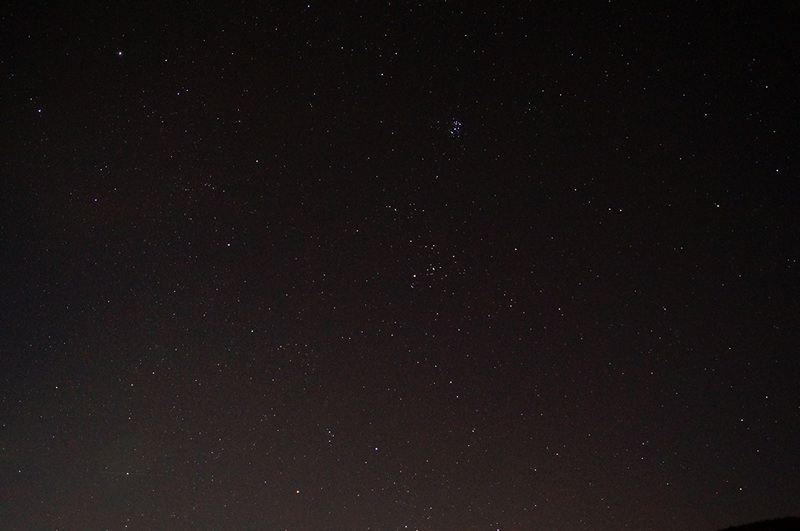
Taurus the V shaped stars at top of picture and Orion below
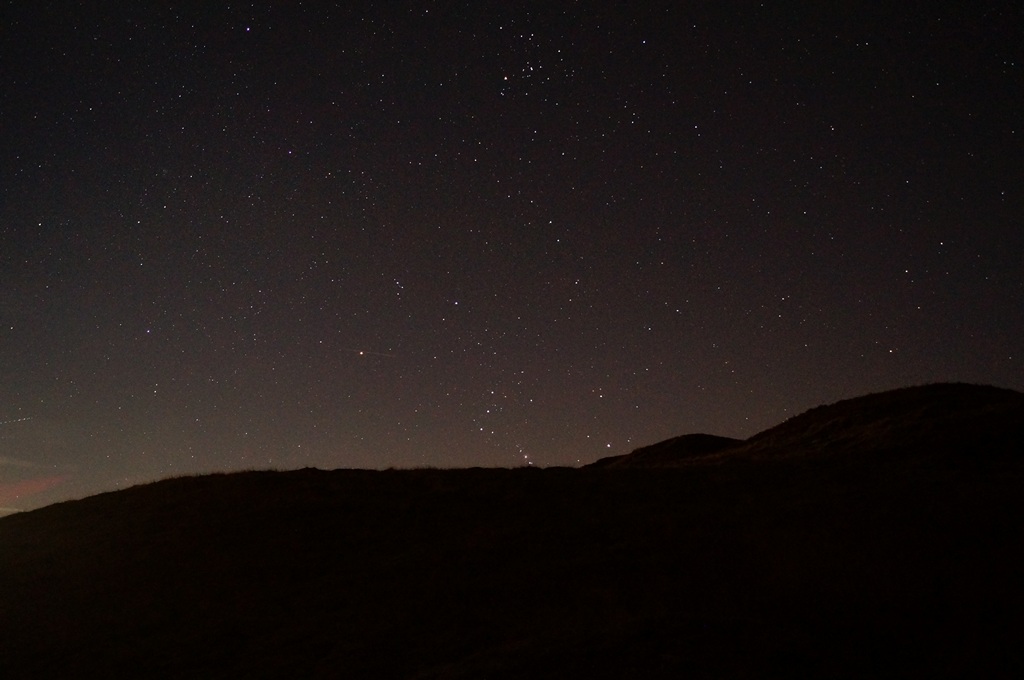
A quick note it was FREEZING -7c.
edit on 31-5-2015 by wmd_2008 because: more info added
edit on 31-5-2015 by wmd_2008 because: (no reason given)
a reply to: GaryN
I've been trying searching for deep space photos from the ISS, pointing away from Earth as you say... it hasn't been easy. There's a photo of the Large Magellanic Cloud, which I strongly suspect was taken pointing away from Earth: science.nasa.gov...
Then there's the starry shot that includes asteroid Vesta: www.spaceref.com...
Interesting fact about this shot is that it was taken through the Destiny Lab window, which is located on the "floor" of the module and thus looks down at Earth. So, the only way that starry shot was possible, is when the ISS was flipped upside down during the time one of the Shuttles was docked to it.
Oh yeah, in case you didn't know: after a Shuttle docks to the ISS using the docking adapter at the front of the ISS, the whole space station is flipped over on its backside so that the Shuttle would stay behind the ISS and be better protected from possible micrometeorite impacts. www.nasa.gov... A 180-degrees rotation means any Earth-facing windows are now facing deep space!
This unique video, shot from a Soyuz spacecraft, shows the ISS and the Shuttle docked to it, undergoing some reorientation. At one point, the ISS's rear points towards Earth and its nose points directly up! www.youtube.com...
I've been trying searching for deep space photos from the ISS, pointing away from Earth as you say... it hasn't been easy. There's a photo of the Large Magellanic Cloud, which I strongly suspect was taken pointing away from Earth: science.nasa.gov...
Then there's the starry shot that includes asteroid Vesta: www.spaceref.com...
Interesting fact about this shot is that it was taken through the Destiny Lab window, which is located on the "floor" of the module and thus looks down at Earth. So, the only way that starry shot was possible, is when the ISS was flipped upside down during the time one of the Shuttles was docked to it.
Oh yeah, in case you didn't know: after a Shuttle docks to the ISS using the docking adapter at the front of the ISS, the whole space station is flipped over on its backside so that the Shuttle would stay behind the ISS and be better protected from possible micrometeorite impacts. www.nasa.gov... A 180-degrees rotation means any Earth-facing windows are now facing deep space!
This unique video, shot from a Soyuz spacecraft, shows the ISS and the Shuttle docked to it, undergoing some reorientation. At one point, the ISS's rear points towards Earth and its nose points directly up! www.youtube.com...
edit on 31-5-2015 by wildespace because: (no reason given)
a reply to: GaryN
This is for helping refine a backup computerized optical navigation system for Orion, in case they experience a loss of signal from the primary navigation system. And you must not be very good at searching: www.nasa.gov...
This is for helping refine a backup computerized optical navigation system for Orion, in case they experience a loss of signal from the primary navigation system. And you must not be very good at searching: www.nasa.gov...
a reply to: wildespace
Wow, that's awesome! I'd heard of them altering pitch/yaw on occasions, but never knew they'd done that manoeuvre. Yes, they should surely have been able to see deep space from the cupola then. Did they take any images from the cupola during that manoeuvre I wonder?
Well, those were taken from, inside the station, which means they were looking sideways, UNLESS they changed the stations orientation, which you have shown that they do. Do they log such events anywhere?
@nataylor
So none of the crew will be able to use a sextant? Better send one of those old Apollo geezers along as a backup backup just in case the star tracker fails!
Oops! Guess not eh? But the page does not mention which windows, the results are pending (doubt that will ever be updated) and those aren't the images that we need to see.
Some interesting shots though from images I have looked at. The distorted moon is from when the Moon is very close to Earth, atmospherics. Unless they were using a filter for some shots,and it doesn't appear from the time stamps that they could have, there is perhaps a reddish tint (307090), a blue moon, and darker moons. This ties in with what I think will happen as the orbit progresses, and they are looking through less and less of Earths atmosphere.
If the blue is not from a filter, then the blue stars the Ruskies saw were likely due to their altitude, as they too would have been looking through less atmosphere. The red/gold stars would have been due to them being at a different altitude. The ionosphere is quite active though as solar radiation varies, so the brightness or colour of the Moon from various altitudes could change over time. More experiments please NASA.
2015.03.08 13:42:19 NIKON D4 S/N: 2071125
eol.jsc.nasa.gov...
13:43:10
eol.jsc.nasa.gov...
13:43:14
eol.jsc.nasa.gov...
13:43:47
eol.jsc.nasa.gov...
13:44:00
eol.jsc.nasa.gov...
13:44:13 GMT
eol.jsc.nasa.gov...
13:44:43 GMT
eol.jsc.nasa.gov...
13:44:56 GMT
eol.jsc.nasa.gov...
The shots that appear to be from the Zenith node, and I agreed, do not show distortion or colour, but the ones that show the very dull moon (307400) do puzzle me, and I don't believe it anything to do with the angle of view and loss of intensity, but I can't prove that. So this is what makes me think something still stinks. Very time consuming trying to go through all those images, but will stick with it when I have time, as I'm sure the clues that explain my distrust in the experiment are in there somewhere. Oh wait a minute though, perhaps they DID rotate the station so that when they took the supposed Zenith shots, they were still in the Cupola but looking sideways, not out! Wouldn't put it past NASA at all!
Oh yeah, in case you didn't know: after a Shuttle docks to the ISS using the docking adapter at the front of the ISS, the whole space station is flipped over on its backside so that the Shuttle would stay behind the ISS and be better protected from possible micrometeorite impacts. www.nasa.gov... A 180-degrees rotation means any Earth-facing windows are now facing deep space!
Wow, that's awesome! I'd heard of them altering pitch/yaw on occasions, but never knew they'd done that manoeuvre. Yes, they should surely have been able to see deep space from the cupola then. Did they take any images from the cupola during that manoeuvre I wonder?
There's a photo of the Large Magellanic Cloud, which I strongly suspect was taken pointing away from Earth: science.nasa.gov...
Then there's the starry shot that includes asteroid Vesta: www.spaceref.com...
Well, those were taken from, inside the station, which means they were looking sideways, UNLESS they changed the stations orientation, which you have shown that they do. Do they log such events anywhere?
@nataylor
This is for helping refine a backup computerized optical navigation system for Orion, in case they experience a loss of signal from the primary navigation system.
So none of the crew will be able to use a sextant? Better send one of those old Apollo geezers along as a backup backup just in case the star tracker fails!
And you must not be very good at searching: www.nasa.gov...
Oops! Guess not eh? But the page does not mention which windows, the results are pending (doubt that will ever be updated) and those aren't the images that we need to see.
Some interesting shots though from images I have looked at. The distorted moon is from when the Moon is very close to Earth, atmospherics. Unless they were using a filter for some shots,and it doesn't appear from the time stamps that they could have, there is perhaps a reddish tint (307090), a blue moon, and darker moons. This ties in with what I think will happen as the orbit progresses, and they are looking through less and less of Earths atmosphere.
If the blue is not from a filter, then the blue stars the Ruskies saw were likely due to their altitude, as they too would have been looking through less atmosphere. The red/gold stars would have been due to them being at a different altitude. The ionosphere is quite active though as solar radiation varies, so the brightness or colour of the Moon from various altitudes could change over time. More experiments please NASA.
2015.03.08 13:42:19 NIKON D4 S/N: 2071125
eol.jsc.nasa.gov...
13:43:10
eol.jsc.nasa.gov...
13:43:14
eol.jsc.nasa.gov...
13:43:47
eol.jsc.nasa.gov...
13:44:00
eol.jsc.nasa.gov...
13:44:13 GMT
eol.jsc.nasa.gov...
13:44:43 GMT
eol.jsc.nasa.gov...
13:44:56 GMT
eol.jsc.nasa.gov...
The shots that appear to be from the Zenith node, and I agreed, do not show distortion or colour, but the ones that show the very dull moon (307400) do puzzle me, and I don't believe it anything to do with the angle of view and loss of intensity, but I can't prove that. So this is what makes me think something still stinks. Very time consuming trying to go through all those images, but will stick with it when I have time, as I'm sure the clues that explain my distrust in the experiment are in there somewhere. Oh wait a minute though, perhaps they DID rotate the station so that when they took the supposed Zenith shots, they were still in the Cupola but looking sideways, not out! Wouldn't put it past NASA at all!
edit on 31-5-2015 by GaryN because: (no reason given)
a reply to: GaryN
Still trying to move those goal posts then !
This image here
eol.jsc.nasa.gov...
CHECK the exif data
Exposure Time (1 / Shutter Speed) [0x829A] = 1/3200 second ===> 0.00031 second
Lens F-Number / F-Stop [0x829D] = 56/10 ===> ƒ/5.6
Exposure Program [0x8822] = manual control (1)
ISO Speed Ratings [0x8827] = 400
Notice MANUAL CONTROL look at shutter speed very short equals dull Moon!
Look at this image
eol.jsc.nasa.gov...
Exposure Time (1 / Shutter Speed) [0x829A] = 1/2000 second ===> 0.0005 second
Lens F-Number / F-Stop [0x829D] = 56/10 ===> ƒ/5.6
Exposure Program [0x8822] = manual control (1)
ISO Speed Ratings [0x8827] = 400
Longer shutter speed BRIGHTER Moon
Some of the others a REALLY DULL image on your list is at 1/6400 th of a second.
Can YOU know give it a rest YOU don't know enough about photography and YOU don't check exif data.
Still trying to move those goal posts then !
This image here
eol.jsc.nasa.gov...
CHECK the exif data
Exposure Time (1 / Shutter Speed) [0x829A] = 1/3200 second ===> 0.00031 second
Lens F-Number / F-Stop [0x829D] = 56/10 ===> ƒ/5.6
Exposure Program [0x8822] = manual control (1)
ISO Speed Ratings [0x8827] = 400
Notice MANUAL CONTROL look at shutter speed very short equals dull Moon!
Look at this image
eol.jsc.nasa.gov...
Exposure Time (1 / Shutter Speed) [0x829A] = 1/2000 second ===> 0.0005 second
Lens F-Number / F-Stop [0x829D] = 56/10 ===> ƒ/5.6
Exposure Program [0x8822] = manual control (1)
ISO Speed Ratings [0x8827] = 400
Longer shutter speed BRIGHTER Moon
Some of the others a REALLY DULL image on your list is at 1/6400 th of a second.
Can YOU know give it a rest YOU don't know enough about photography and YOU don't check exif data.
edit on 1-6-2015 by wmd_2008 because: (no
reason given)
new topics
-
Only two Navy destroyers currently operational as fleet size hits record low
Military Projects: 5 hours ago -
George Stephanopoulos and ABC agree to pay $15 million to settle Trump defamation suit
Mainstream News: 10 hours ago
top topics
-
George Stephanopoulos and ABC agree to pay $15 million to settle Trump defamation suit
Mainstream News: 10 hours ago, 17 flags -
More Bad News for Labour and Rachel Reeves Stole Christmas from Working Families
Regional Politics: 17 hours ago, 8 flags -
Only two Navy destroyers currently operational as fleet size hits record low
Military Projects: 5 hours ago, 7 flags
active topics
-
-@TH3WH17ERABB17- -Q- ---TIME TO SHOW THE WORLD--- -Part- --44--
Dissecting Disinformation • 3688 • : duncanagain -
A Bunch of Maybe Drones Just Flew Across Hillsborough County
Aircraft Projects • 83 • : charlyv -
The Mystery Drones and Government Lies
Political Conspiracies • 72 • : tarantulabite1 -
Only two Navy destroyers currently operational as fleet size hits record low
Military Projects • 1 • : alwaysbeenhere2 -
A priest who sexually assaulted a sleeping man on a train has been jailed for 16 months.
Social Issues and Civil Unrest • 30 • : alwaysbeenhere2 -
They Know
Aliens and UFOs • 86 • : ianmoone3 -
George Stephanopoulos and ABC agree to pay $15 million to settle Trump defamation suit
Mainstream News • 11 • : WeMustCare -
President-Elect DONALD TRUMP's 2nd-Term Administration Takes Shape.
Political Ideology • 331 • : WeMustCare -
Nov 2024 - Former President Barack Hussein Obama Has Lost His Aura.
US Political Madness • 15 • : WeMustCare -
Former DNI-Congressman John Ratcliffe says the U.S. Government is Intimidated by UFOs.
Aliens and UFOs • 41 • : WeMustCare

